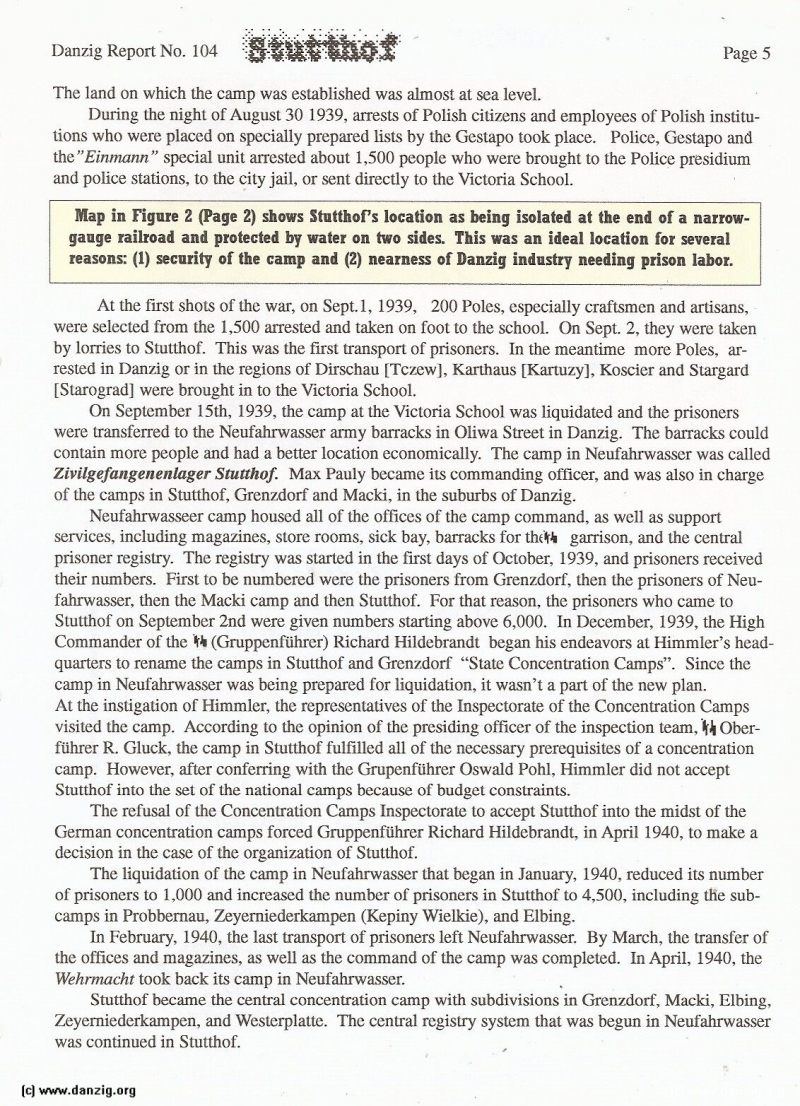
The land on which the camp was established was almost at sea level.
During the night of August 30 1939, arrests of Polish citizens and employees of Polish institut ions who were placed on specially prepared lists by the Gestapo took place. Police, Gestapo and the “Einmann” special unit arrested about 1,500 people who were brought to the Police presidium and police stations, to the city jail, or sent directly to the Victoria School.
Map in Figure 2 (Page 2) shows Stutthof’s location as being isolated at the end of a narrow- gauge railroad and protected by water on two sides. This was an ideal location for several reasons: (1) security of the camp and (2) nearness of Danzig industry needing prison labor.
At the first shots of the war, on Sept. 1, 1939, 200 Poles, especially craftsmen and artisans, were selected from the 1,500 arrested and taken on foot to the school. On Sept. 2, they were taken by lorries to Stutthof. This was the first transport of prisoners. In the meantime more Poles, arr ested in Danzig or in the regions of Dirschau [Tczewl, Karthaus [Kartuzy], Koscier and Stargard [Starograd] were brought in to the Victoria School.
On September 15th, 1939, the camp at the Victoria School was liquidated and the prisoners were transferred to the Neufahrwasser army barracks in Oliwa Street in Danzig. The barracks could contain more people and had a better location economically. The camp in Neufahrwasser was called Zivilgefangenenlager Sniuhof. Max Pauly became its commanding officer, and was also in charge of the camps in Stutthof, Grenzdorf and Macki, in the suburbs of Danzig.
Neufahrwasseer camp housed all of the offices of the camp command, as well as support services, including magazines, store rooms, sick bay, barracks for thk garrison, and the central prisoner registry. The registry was started in the first days of October, 1939, and prisoners received their numbers. First to be numbered were the prisoners from Grenzdorf, then the prisoners of Neuf ahrwasser, then the Macki camp and then Stutthof. For that reason, the prisoners who came to Stutthof on September 2nd were given numbers starting above 6,000. In December, 1939, the High Commander of the (Gruppenfuhrer) Richard Hildebrandt began his endeavors at Himmler’s headq uarters to rename the camps in Stutthof and Grenzdorf “State Concentration Camps”. Since the camp in Neufahrwasser was being prepared for liquidation, it wasn’t a part of the new plan. At the instigation of Himmier, the representatives of the Inspectorate of the Concentration Camps visited the camp. According to the opinion of the presiding officer of the inspection team, rk Oberf ührer R. Gluck, the camp in Stutthof fulfilled all of the necessary prerequisites of a concentration camp. However, after conferring with the Grupenfuhrer Oswald Pohi, Himmier did not accept Stutthof into the set of the national camps because of budget constraints.
The refusal of the Concentration Camps Inspectorate to accept Stutthof into the midst of the German concentration camps forced Gruppenfuhrer Richard Hildcbrandt, in April 1940, to make a decision in the case of the organization of Stutthof.
The liquidation of the camp in Neufahrwasser that began in January, 1940, reduced its number of prisoners to 1,000 and increased the number of prisoners in Stutthof to 4,500, including the sub- camps in Probbernau, Zeyerniederkampen (Kepiny Wielkie), and Elbing.
In February, 1940, the last transport of prisoners left Neufahrwasser. By March, the transfer of the offices and magazines, as well as the command of the camp was completed. In April, 1940, the Wehrmacht took back its camp in Neufahrwasser.
Stutthof became the central concentration camp with subdivisions in Grenzdorf, Macki, Elbing, Zeyerniederkampen, and Westerplatte. The central registry system that was begun in Neufahrwasser was continued in Stutthof.
Danzig Report Vol. 1 - Nr. 104 - July - August - September - 1999, Page 5.
Hits: 4943
Added: 25/07/2015
Copyright: 2025 Danzig.org

